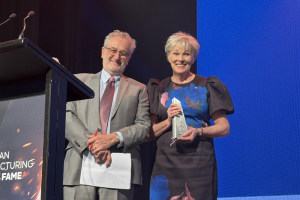When Food & Drink Business last caught up with the chair of ASX-listed Murray Cod Australia, Ross Anderson, the company was focused on educating consumers about the fish and its provenance coming from what Anderson called “the most sustainable aquaculture operations in the world”. While that still stands, the company – known as Aquna Sustainable Murray Cod – has taken the brand to a whole new level with Aquna Gold, Murray Cod Caviar.
“Have you tried it yet,” Anderson asks. When I confess the tiny gold tin is still sitting in my fridge he says, “Well, make sure you do it properly, some blinis, a little crème fraiche, then topped with the caviar and maybe some chives.”
I go home that night, and do as I’m told, and then have to hustle my way through the rest of the family to sample the tiny slightly sweet, not overly fishy spheres that pop in your mouth.
“Over the years there have been several chefs who worked with our caviar, but our primary focus at the time was on the fish. Then our group manager Ian Charles bumped into Lisa Downs, the sales manager and caviar ambassador for Simon Johnson Purveyor of Quality Foods business, at the North America Seafood Expo in Boston and it went from there.”
Anderson explains the project has been run by Charles and Downs from the outset.
“They spent a whole year on it with a lot of hard work and dedication and they’ve produced this magnificent product,” he says.
Initially supply will be limited, with distribution exclusively through Simon Johnson in Australia. Anderson doesn’t envisage a retail offering for at least another 12 months.

The decision to develop Aquna Gold was a big commitment for the company. Demand for the fish has grown exponentially, customers were putting in bigger orders by the day, and the brand awareness Anderson was focused on building had clearly been a success, with the company expanding outside of fine dining and into the retail channel.
To harvest the roe meant taking some female fish out of that supply chain just as customers were wanting more.
For the project the female fish were kept in a separate area, with Aquna’s existing infrastructure able to isolate areas so they could “be left alone to grow happy beautiful caviar”.
Anderson explains that while the investment in terms of capital expenditure has been relatively minor, the real investment has been in the collaboration with Simon Johnson and the development of the project.
“It takes time to grow fish, they’re not a widget you can pull off the shelf for an immediate result. You have to treat them with care and respect. It takes three and a half to four years to grow a three to four kilo fish.
“A three to four kilo fish can produce anywhere from 80-125 grams of roe. The roe loses some moisture after it’s turned into caviar, our production per fish is in that vicinity,” Anderson says. ‘
The fish will be harvested in spring, the roe milked, and the fish processed for sale to restaurants and distributors.
For now, Aquna is playing catch-up. Conservative projections during Covid have been outrun by exponential increases in demand, meaning the company is now focused on building its volume to keep up.
One of its research projects is a selective breeding program with the national science body CSIRO, now in its third year.
“It is researching improving fish health, fat content, and the omega sixes and threes; essentially the overall quality of the flesh. Over time, that will improve things like growth rates, fish health, and fish flesh quality,” Anderson says.
Another recent success has been the cod’s inclusion on menus in some of Disney’s top restaurants.

And for Aquna Gold?
“It has a different flavour to black caviars. The beautiful translucent gold colour appeals to a lot of chefs because it looks amazing on the plate and it tastes wonderful,” Anderson says.
In the short term, it is expected most if not all Aquna Gold will go into high end restaurants, but Anderson says it will be up to Simon Johnson as to where they sell it into and what its price point will be.
“It won’t be as expensive as the very top end black caviar, but it will certainly be a lot more expensive than salmon roe,” he says.
Now, to just get those fish growing faster.






